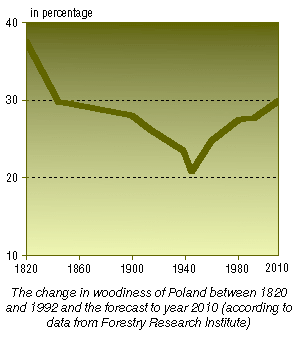Forest Resources in Poland
![]()
 Postwar reforestation
increased the woodiness of Poland. This growth is still taking
place (See graph). On January 1, 1995 forests occupied 8,756.1
ha, which means that woodiness of Poland is 28%, significantly
lower than the average European woodiness of about 32%. Forests
in Poland are highly dispersed. There are 28,000 complexes, of
which over 6,000 are under 5 hectares. At the same time the level
of woodiness is very different for particular voivodships, from
less than 12% in Plock voivodship to over 48% in Zielona Gora
voivodship.
Postwar reforestation
increased the woodiness of Poland. This growth is still taking
place (See graph). On January 1, 1995 forests occupied 8,756.1
ha, which means that woodiness of Poland is 28%, significantly
lower than the average European woodiness of about 32%. Forests
in Poland are highly dispersed. There are 28,000 complexes, of
which over 6,000 are under 5 hectares. At the same time the level
of woodiness is very different for particular voivodships, from
less than 12% in Plock voivodship to over 48% in Zielona Gora
voivodship.
Coniferous species have a definite advantage in the composition
of forests (GRAPH illustrating the composition
of the forests),although their share has decreased from 87%
in 1945 to about 78% in 1994. This decrease is a result of a constant
preference given to deciduous species. The majority of forests
in Poland occupy poor forest habitats and sandy soils (64.8%),
on which pine tree stands dominate (71.1%).
 Timber
production is not high ñ the average annual growth is 3.45
m3/ha, lower than the European average and 20% lower
than the potential production possibilities of our forests. The
total amount of timber, or the so called standing crop of timber,
measure about 1,543.9 million m3 in 1995, of whose
1,322.6 mln m3 is from national forests. In comparison
to 1950 the timber stock doubled. A similar trend was observed
tHRoughout Europe (See graph). Since 1967 the average amount of
timber per hectare has grown from about 140 m3 to 191
m3. In the same period the share of tree stands older
than eighty years has grown from 14.3% to 16.4% and the average
age of our forests has grown from 47 to 54 years.
Timber
production is not high ñ the average annual growth is 3.45
m3/ha, lower than the European average and 20% lower
than the potential production possibilities of our forests. The
total amount of timber, or the so called standing crop of timber,
measure about 1,543.9 million m3 in 1995, of whose
1,322.6 mln m3 is from national forests. In comparison
to 1950 the timber stock doubled. A similar trend was observed
tHRoughout Europe (See graph). Since 1967 the average amount of
timber per hectare has grown from about 140 m3 to 191
m3. In the same period the share of tree stands older
than eighty years has grown from 14.3% to 16.4% and the average
age of our forests has grown from 47 to 54 years.
Harvesting of timber stock between 1967ñ1989 was on the average 17% larger than the allowable limit of logging, also known as the cutting plan. Breaches of the limit were mostly immature cuttings. Young tree stands were cut in order to clean the forest, to make clearances as well as for sanitary reasons. The limit was breached on average by 45.6%. The years 1982 to 1983 were the most difficult period for Polish forestry. During that time the cuttings of immature trees were twice as large as the limit (213.6% in 1983). This was due to natural disasters (blowdown of trees), climatic catastrophes (droughts) but also to pest damage (Lymantria monacha). Cuts were necessary to clean up the forests after these disasters. Because of the increase in the logging of young tree stands, older trees were saved. On average, only 93.7% of the limits in these stands was used. In 1982 merely 67.6% of the limit was used. 1990 was a historical turning point in the utilization of forests when the amount of timber harvesting in national forests was lowered below the cutting limit. This was the first time it happened after the war. The limit calculated for that year was 17,241,500 m3 and only 15,863,000 m3 (or 92%) was used. In 1991 this trend continued and only 89.7% of the limit was used.
During the last tHRee years the average wood con../picption in Europe went up from about 0.70 m3/person to 0.78 m3/person. In 1993 it was 0.46 m3/person. Such a level of con../picption is below the accepted minimum for European inhabitants (0.5 m3). Further lowering of con../picption, especially of younger tree stands, may be detrimental to their sanitary condition.